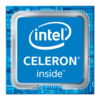Intel Celeron N5100 vs Intel Core 2 Duo T6670 vs Intel Core 2 Duo SL9600
Intel Celeron N5100
► remove from comparison
The Intel Celeron N5100 is a quad-core SoC of the Jasper Lake series that is primarily intended for inexpensive notebooks and was announced in early 2021. The four Tremont CPU cores clock between 1.1 and 2.8 GHz (single core Burst) and offer no HyperThreading (SMT). The N5100 uses 1.5 MB L2 and 4 MB L3 cache. The chip is manufactured in 10nm at Intel (most likely in the same process as Ice Lake).
Architecture
The processor architecture is called Tremont and a complete redesign compared to the old Golmont Plus cores in the predecessor. According to Intel, the single thread performance of a core could be improved by 30% on average (10 - 80% in all tests of SPECint and SPECfp).
Features
In addition to the quad-core CPU block, the SoC integrates a 24 EU Intel UHD Graphics GPU clocked from 350 - 800 MHz and a LPDDR4(x) dual channel memory controller (up to 16 GB and 2933 MHz). The chip now also partly integrates Wi-Fi 6 (Gig+), 8 PCIe 3.0 lanes, 14 USB 2.0/ 3.2 ports and two SATA 6.0 ports. The package got bigger and measures 35 x 24 mm (compared to 25 x 24 mm for the N5030 e.g.). The SoC is directly soldered to the mainboard (BGA) and can't be easily replaced.
Performance
While we have not tested a single system powered by the N5100 as of August 2023, it's safe to expect the chip to be 10% to 20% slower than the N6000, as far as multi-thread performance is concerned. In other words, this is a fairly slow processor that is unlikely to make anybody happy.
Power Consumption
Like most other N-class Intel processors, this Celeron has a 6 W default TDP (also known as the long-term power limit). This is rather low; a small metal plate is all it takes to dissipate heat generated by such a CPU.
The Celeron N5100 is manufactured on Intel's first-generation or second-generation [no exact data available] 10 nm process for average, as of early 2023, energy efficiency.
Intel Core 2 Duo T6670
► remove from comparisonThe Intel Core 2 Duo T6670 is an entry level laptop processor based on the Penryn core. It offers only 2 MB level 2 cache and a mediocre clock rate of 2.2 GHz. Compared to the similar T6600, the T6670 offers Virtualization VT-x and a higher maximum temperature of 105°C.
Intel Core 2 Duo SL9600
► remove from comparisonThe Intel Core 2 Duo SL9600 is a low power laptop processor for small and slim laptops. It features the full 6 MB level 2 cache and all features of the Penryn core (e.g. VT-x and Trusted Execution). Due to the large cache, the CPU shows a good performance for the small clock rate. However, in the MacBook Air, the CPU throttled very often, leading to the slower benchmarks in our database.
Compared to other Core 2 Duo models, the C2D SL9600 only supports the socket BGA956 and is soldered in the MacBook Air models.
| Model | Intel Celeron N5100 | Intel Core 2 Duo T6670 | Intel Core 2 Duo SL9600 | ||||||||||||||||||||||||||||||||
| Codename | Jasper Lake | Penryn | Penryn | ||||||||||||||||||||||||||||||||
| Series | Intel Jasper Lake | Intel Core 2 Duo | Intel Core 2 Duo | ||||||||||||||||||||||||||||||||
| Series: Core 2 Duo Penryn |
| ||||||||||||||||||||||||||||||||||
| Clock | 1100 - 2800 MHz | 2200 MHz | 2130 MHz | ||||||||||||||||||||||||||||||||
| L2 Cache | 1.5 MB | 2 MB | 6 MB | ||||||||||||||||||||||||||||||||
| L3 Cache | 4 MB | ||||||||||||||||||||||||||||||||||
| Cores / Threads | 4 / 4 | 2 / 2 | 2 / 2 | ||||||||||||||||||||||||||||||||
| TDP | 6 Watt | 35 Watt | 17 Watt | ||||||||||||||||||||||||||||||||
| Technology | 10 nm | 45 nm | 45 nm | ||||||||||||||||||||||||||||||||
| max. Temp. | 105 °C | 105 °C | 105 °C | ||||||||||||||||||||||||||||||||
| Socket | BGA1338 | PGA478 | BGA956 | ||||||||||||||||||||||||||||||||
| Features | DDR4-2933/LPDDR4x-2933 RAM, PCIe 3, GNA, MMX, SSE, SSE2, SSE3, SSSE3, SSE4.1, SSE4.2, VMX, SMEP, SMAP, EIST, TM1, TM2, Turbo, AES-NI, RDRAND, RDSEED, SHA | Enhanced Speedstep, Intel VT, TXT, Intel64 | |||||||||||||||||||||||||||||||||
| iGPU | Intel UHD Graphics (Jasper Lake 24 EU) (350 - 800 MHz) | ||||||||||||||||||||||||||||||||||
| Architecture | x86 | x86 | x86 | ||||||||||||||||||||||||||||||||
| Announced | |||||||||||||||||||||||||||||||||||
| Manufacturer | ark.intel.com | ark.intel.com | ark.intel.com | ||||||||||||||||||||||||||||||||
| FSB | 800 | 1066 | |||||||||||||||||||||||||||||||||
| Transistors | 410 Million | 410 Million | |||||||||||||||||||||||||||||||||
| Die Size | 107 mm2 | 107 mm2 | |||||||||||||||||||||||||||||||||
| L1 Cache | 128 KB | ||||||||||||||||||||||||||||||||||
| Voltage | 1.05-1.15 V | ||||||||||||||||||||||||||||||||||
| $316 U.S. |
Benchmarks
Average Benchmarks Intel Celeron N5100 → 0% n=0
Average Benchmarks Intel Core 2 Duo T6670 → 0% n=0
Average Benchmarks Intel Core 2 Duo SL9600 → 0% n=0
* Smaller numbers mean a higher performance
1 This benchmark is not used for the average calculation













